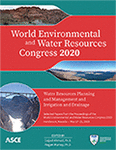World Environmental and Water Resources Congress 2020
Estimation of Reservoir Capacity and Sediment Deposition Using Remote Sensing Data
Publication: World Environmental and Water Resources Congress 2020: Water Resources Planning and Management and Irrigation and Drainage
ABSTRACT
In this study the reservoir capacity and sediment deposition was estimated using remote sensing data. The satellite images was synchronized with water level and storage capacity to find out the change in sediment deposition due to soil erosion and transport by stream flow. The water bodies spread area was estimated using vegetation indices, e.g., normalize differences vegetation index (NDVI) and normalize differences water index (NDWI). The 3D reservoir bathymetry was modeled by integrated water level, storage capacity, and area. From the models of different time span, the change in reservoir storage capacity was estimated. Another reservoir with known water level, storage capacity, area, and sediment deposition was used to validate the estimation technique. The t-test was used to assess the results between observed and estimated reservoir capacity and sediment deposition.
Get full access to this article
View all available purchase options and get full access to this chapter.
REFERENCES
Alsdorf, D. E., Rodríguez, E. and Lettenmaier, D. P., (2007). Measuring surface water from space. Reviws of Geophysics. https://doi.org/10.1029/2006RG000197
Behera, M. D., Gupta, A. K., Barik, S. K., Das, P., and Panda, R. M., (2018). Use of satellite remote sensing as a monitoring tool for land and water resources development activities in an Indian tropical site. Environ Monit Assess. 190: 401.
Destouni, G., S. M. Asokan, and J. Jarsjo. (2010). Inland Hydro-Climatic Interaction: Effects of Human Water Use on Regional Climate. Geophysical Research Letters. 37: L18402.
Ding, X., and Li, X. (2011). Monitoring of the Water-Area Variations of Lake Dongting in China with ENVISATASAR Images. International Journal of Applied Earth Observation and Geoinformation 13: 894–901.
Ferrari, R.L. (1999). Anderson Ranch Reservoir 1998 Sedimentation Survey. U.S. Department of the Interior Bureau of Reclamation. Hard copy available at Bureau of Reclamation Technical Service Center, Denver, Colorado.
Ferrari, R.L. (2008). Elephant Butte 2007 Sedimentation Survey. U.S. Department of the Interior Bureau of Reclamation. Hard copy available at Bureau of Reclamation Technical Service Center, Denver, Colorado.
Huete, A. (2014) Vegetation Indices. In: Njoku E.G. (eds) Encyclopedia of Remote Sensing. Encyclopedia of Earth Sciences Series. Springer, New York, NY.
Jiang, H., Liu, C., and Lu, X., (2015). Remote Sensing Reversion of Water Depths and Water Management for the Stopover Site of Siberian Cranes at Momoge, China. Wetlands. 35:369–379.
Jiang, L., Nielsen, K., Andersen, O. B., Bauer-Gottwein, P., (2017). Monitoring recent lake level variations on the Tibetan Plateau using CryoSat-2 SARIn mode data. Journal of Hydrology. 544: 109–124.
Keller, A., Sakthivadivel, R., and Seckler, D., 2000. Water scarcity and the role of storage in development. Colombo: International Water Management Institute, IWMI Research Report 39.
Kummu, M. and Varis, O., (2007). Sediment–related impacts due to upstream reservoir trapping, the Lower Mekong River. Geomorphology, 85, 275–293.
Lai, L., Fang, J., and Zhang, Y., (2009). Reservoir Storage Capacity Calculation Using DEM Model. Jiangxi Surveying and Mapping. 77: 41–43 (in Chinese).
Lu, S., Ouyang, N., Wu, B., Wei, Y., and Tesemma, Z. (2013). Lake water volume calculation with time series remote-sensing images. International Journal of Remote Sensing. 34: (22)7962-7973.
Medina, C. E., Gomez-Enri, J., Alonso, J. J., and Villares, P. (2010). Water Volume Variations in Lake Izabal (Guatemala) from In Situ Measurements and ENVISAT Radar Altimeter (RA-2) and Advanced Synthetic Aperture Radar (ASAR) Data Products. Journal of Hydrology. 382: 34–48.
Mi, H., Zai, J., and Jiang, X., (2007). Contrast and Analysis of Reservoir Storage calculation Methods. Surveying and Mapping of Geology and Mineral Resources. 23: 1–4 (in Chinese).
Mushtaq, F. and Lala, M.G.N. (2017). Assessment of climatic variability in the catchments of Himalayan Lake, Jammu & Kashmir. Geocarto International. 32: 10, 1090-1104.
Ouma, Y. O., and Tateishi, R. (2006). A water index for rapid mapping of shoreline changes of five East African Rift Valley lakes: An empirical analysis using Landsat TM and ETM+ data. International Journal of Remote Sensing, 27(15), 3153–3181.
Pandey, A., Chaube, U.C., Mishra, S.K., and Kumar, D. (2016). Assessment of reservoir sedimentation using remote sensing and recommendations for desilting Patratu Reservoir, India. Hydrological Sciences Journal. 61: 4, 711-718.
Rouse, J.W., Haas, R.H., Jr. Schell, J.A., and Deering, D. W. (1974). Monitoring vegetation systems in the Great Plains with ERTS. Third ERTS-1 Symposium (pp. 309–317). Washington, DC: NASA.
Shanlong Lu, Ninglei Ouyang, Bingfang Wu, Yongping Wei & Zelalem Tesemma (2013) Lake water volume calculation with time series remote-sensing images, International Journal of Remote Sensing. 34:22, 7962-7973.
Stevenson, K., (2000). The role of small dams in improving rural livelihoods in semi-arid areas. Care Stakeholder Workshop 29–31 August 2000, Masvingo, Zimbabwe.
Teltscher, K. and Fassnacht, F.E., (2018). Using multispectral landsat and sentinel-2 satellite data to investigate vegetation change at Mount St. Helens since the great volcanic eruption in 1980. Journal of Mountain Science 15.(9)
Valderrama-Landeros, L., Flores-de-Santiago, F., Kovacs, J. M. and Flores-Verdugo, F., (2018). An assessment of commonly employed satellite-based remote sensors for mapping mangrove species in Mexico using an NDVI-based classification scheme. Environ Monit Assess. 190: 23.
Walling, D.E., (2006). Human impact on land–ocean sediment transfer by the world’s rivers. Geomorphology. 79, 192–216.
Information & Authors
Information
Published In
World Environmental and Water Resources Congress 2020: Water Resources Planning and Management and Irrigation and Drainage
Pages: 154 - 161
Editors: Sajjad Ahmad, Ph.D., and Regan Murray, Ph.D.
ISBN (Online): 978-0-7844-8295-7
Copyright
© 2020 American Society of Civil Engineers.
History
Published online: May 14, 2020
Published in print: May 14, 2020
Authors
Metrics & Citations
Metrics
Citations
Download citation
If you have the appropriate software installed, you can download article citation data to the citation manager of your choice. Simply select your manager software from the list below and click Download.
